An illustrated essay in three parts by Carol Cofone (Rutgers’17)
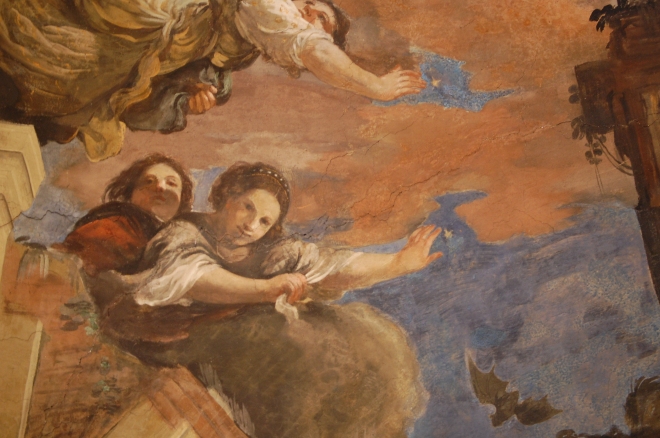
Detail of Guercino’s Aurora. Collection of HSH Prince Nicolò and HSH Princess Rita Boncompagni Ludovisi, Rome.
Our discussion continues of the celebration of the Nozze d’Oro (Golden Wedding Anniversary) of Rodolfo Boncompagni Ludovisi (1832-1911), the eighth Prince of Piombino, and the Princess of Piombino Agnese Borghese Boncompagni Ludovisi (1836-1920).
In Part I we explored how the Boncompagni Ludovisi family was forced due to financial exigencies to rent their famed Casino Aurora (starting in 1895) to the new American Academy in Rome—and then to see the Americans leave them off the invitation list when King Vittorio Emanuel III and Queen Elena attended a landmark exhibition there on 11 January 1904.
In Part II we discussed how the Boncompagni Ludovisi managed to get back for the space of one day the use of their Casino Aurora for the Golden Wedding festivities of 31 May 1904, and why the lunch they staged attracted national press attention in Italy as “a conspicuous and brilliant party.”
In this final segment we shall see that the choice of the Casino Aurora as a venue was significant not just as a celebration of the fifty year marriage of the Prince and Princess. It was a powerful reminder of the family’s continued relevance at a time when powerful political, economic and social changes challenged it.
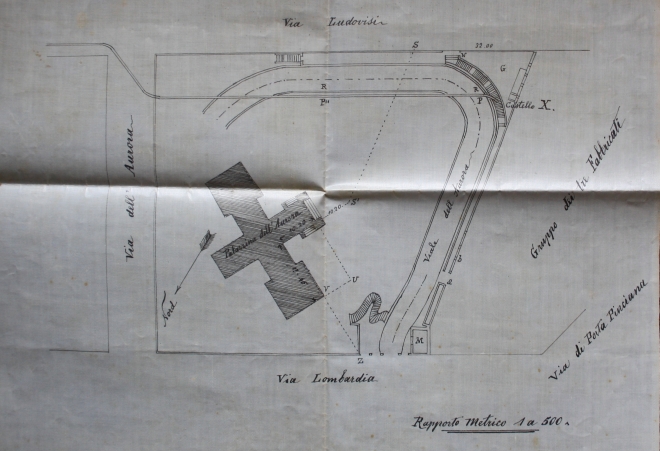
Plan of the Casino Aurora and its immediate area, made in connection with preparations for the 1904 Golden Wedding anniversary of Rodolfo and Agnese Boncompagni Ludovisi
One of the most intriguing aspects of the history of the Boncompagni Ludovisi family is that, notwithstanding its contribution to the Catholic Church of Popes Gregory XIII Boncompagni (1572-1585) and Gregory XV Ludovisi (1621-1623) and numerous Cardinals, it also played a crucial role in championing the cause of Italian unification—and with it, the dismantlement of the Papal States.
For instance, Rodolfo’s father Antonio (III) Boncompagni Ludovisi (1808-1883, Prince of Piombino [VII] from 1841) made the family’s Palazzo Piombino on the Via del Corso a center for patriotic activity aimed at Italian unification. It cost him dearly: in 1861 Pope Pius IX personally exiled him for his public support of King Vittorio Emanuele II. Made a Senator that same year of the Kingdom of Italy, Antonio spent most of the rest of his life outside Rome, and died in Milan. His support of Vittorio Emanuele ran so deep that in winter 1872 he rented the Casino Aurora to the King and his mistress Rosa Teresa Vercellana (1833-1885), an arrangement immortalized by the pen of Henry James.
But that is just a start. Antonio’s son—and Rodolfo’s younger brother—Ignazio Boncompagni Ludovisi (1845-1913) campaigned despite strong family disapproval with Giuseppe Garibaldi in 1867 in the Campagna dell’Agro Romano, and just two weeks after the capture of Rome was made a member of the Giunta Provvisoria di Governo formed on 3 October 1870. In 1886 he too was named a Senator of the Kingdom of Italy.
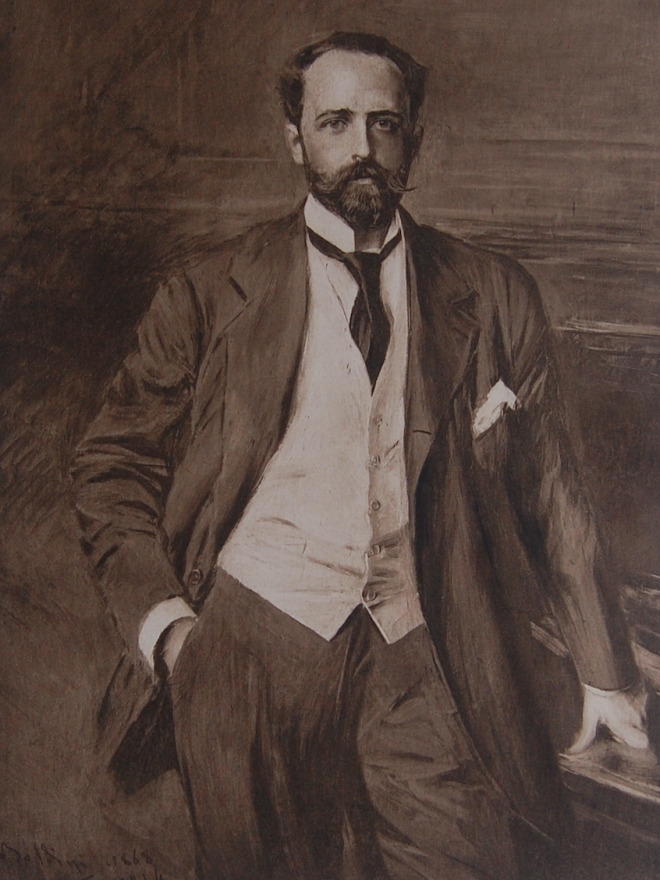
Rodolfo’s brother, Ignazio Boncompagni Ludovisi (1845-1913). In the preliminaries to the battle of Monterotondo (25 October 1867), he offered the Boncompagni Ludovisi palace in that town to Garibaldi to serve as his headquarters.
Yet the crowning irony is that the Boncompagni Ludovisi family’s conspicuous service in the cause of an Italian nation did them little good as Rome established itself as the new capital of the unified Italy. The Villa Ludovisi, an 89.6-acre tract in the area now surrounding Via Veneto, was part of the family patrimony from 1621 to 1886. But the politics of Italian reunification had brought about the reduction of Papal influence and power—as well as a change in the inheritance laws.
The difficulties faced by the Boncompagni Ludovisi during the 1880s and 1890s have been discussed at length in previous posts. These included the choice to dissolve and develop their Villa Ludovisi before the Commune of Rome confiscated it, and the wider real estate crisis that afterwards enveloped them. These factors undermined Rodolfo’s plan to subdivide most of the land. While this lottizzazione proceeded, the business deal faltered, and ultimately the family’s finances collapsed.
What is more, in addition to the Villa Ludovisi, the family lost its principal homestead of this era, their Palazzo Piombino which faced Piazza Colonna on the Via del Corso. In 1889 the Comune di Roma expropriated and demolished it, ostensibly to widen the Corso. But for about 25 years the site of their home remained a vacant lot.
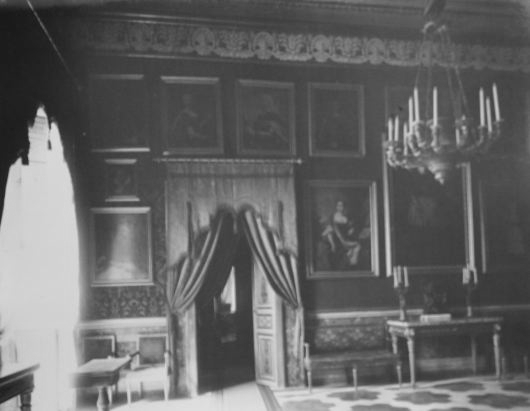
Interior view of a salone in the Palazzo Piombino al Corso before its confiscation and demolition by the Commune di Roma in 1889. The Boncompagni Ludovisi portraits shown here are now in the Villa Aurora.
Ugo Boncompagni Ludovisi, the eldest son of Rodolfo and Agnese, summarized the difficulties of this era, and indeed assumed responsibility for them. In the pages of his 1921 memoir, Ricordi di mia madre, Ugo writes:
“The real estate crisis in Rome – that started in about 1890 and worsened in the following years; the real estate crisis in which the inheritance of my father was, by force of circumstances, involved – created a difficult situation for our family. I, who had the main administrative responsibility, tried to deal with it in ways that proved to be wrong; since they didn’t pay off, it made for a far more difficult situation.”
“My father had the courage, among other strengths, to give up living in the new palazzo [on Via Veneto] that was later ceded as well, and retired with my mother to La Quiete [the family’s summer home near Foligno] in the countryside, where they lived more frugally. He was wonderfully helped in all this by his wife. Never did a word of complaint escape from the lips of this great Christian regarding a state of affairs that she surely had no role in creating. Her only thought was of my father.”
What this excerpt does not explain is that, while the family lost most of the Villa Ludovisi, and yes, ceded their new grand Palazzo Piombino to the state in 1892—which they had built only two years earlier—they retained ownership of the Casino dell’ Aurora.
The Casino, or Villa Aurora as it is now generally called, very much still exists. It is the home of the current Prince and Princess of Piombino, Nicolo’ (great-great-grandson of Rodolfo and Agnese) and Rita Boncompagni Ludovisi. A little history is needed to understand its significance, and why the Boncompagni Ludovisi gathered there on 31 May 1904.
Built ca. 1570, the Casino had two owners—Apostolic secretary Francesco (Cecchino) del Nero, and then Cardinal Francesco del Monte—before it was purchased in June of 1621 by Cardinal Ludovico Ludovisi. The cardinal was the nephew of Pope Gregory XV Ludovisi (1554-1621-1623), who succeeded Pope Paul V Borghese (1552-1605-1621)
As Lisa Neal Tice explains in her 2009 Rutgers dissertation, Recreation and Retreat: Garden Casini in Late Sixteenth- and Early Seventeenth-Century Rome:
“[It was] the most immediate site of Ludovisi prosperity, both politically and artistically. It was the first structure to be purchased, and therefore the first to be decorated and used by the cardinal as both a preliminary residence and a site for banquets and entertainment… The small building is three stories in height with a Greek-cross plan and a belvedere that overlooked the surrounding gardens…Visitors entered through a portico in the southeast arm, which was later closed in to form an antecamera…the Stanza dell’Aurora [was] used for public functions.”
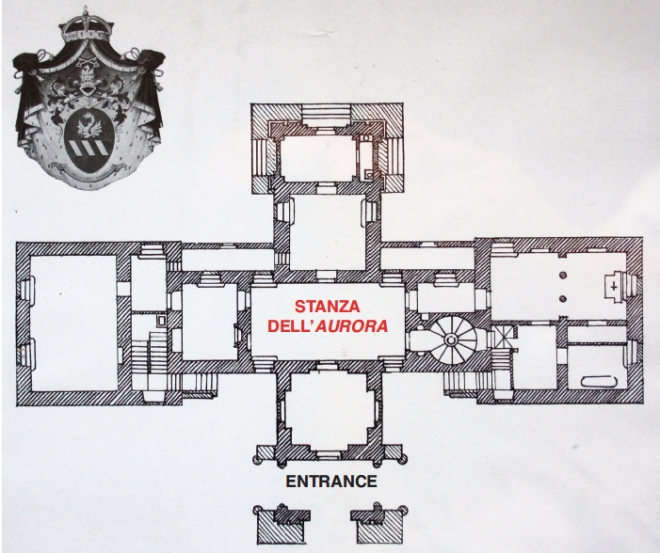
Plan of ground floor of the Casino dell’Aurora in 1904, from the Golden Anniversary commemorative book prepared by the staff of the Amministrazione Boncompagni Ludovisi. Collection of HSH Prince Nicolò and HSH Princess Rita Boncompagni Ludovisi, Rome.
As Tice says, “The Casino dell’Aurora and its decoration were a priority for the cardinal, who commissioned work on the building even before he acquired the Palazzo Grande and its accompanying property – the additional tracts that ultimately constituted the Villa Ludovisi.”
“Cardinal Ludovisi”, continues Tice, “commissioned Guercino to paint the Aurora on the ceiling of the ground floor of the casino…Guercino depicted a vibrant Aurora seated in her chariot with two horses pulling her across the early morning sky. She is cloaked in a white dress with red drapery flowing from her lap, while a putto crowns her with a wreath of flowers. Her left hand holds the reins to the chariot as her right hand casts flowers into the open sky. Behind, her elderly husband, Tithonus, emerges from the cover of a heavy reddish drape and looks wearily after his wife.”
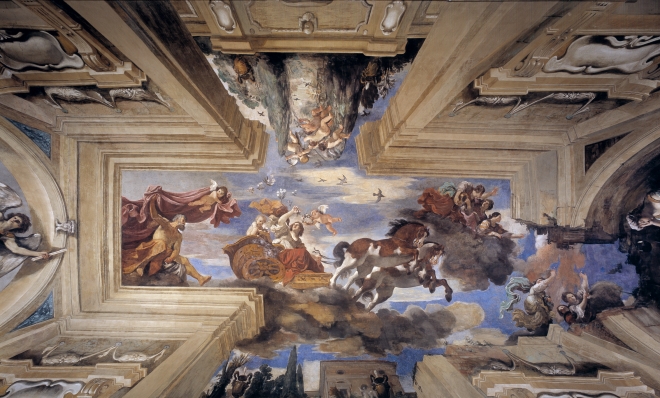
Guercino’s Aurora (1621). Collection of HSH Prince Nicolò and HSH Princess Rita Boncompagni Ludovisi, Rome.
The Aurora helped to establish the reputation of Guercino, in Rome and beyond. According to William Griswold, “The scene is represented in steep perspective: the figures are sharply foreshortened, the undersides of the horses are clearly visible, and the cypresses glimpsed through [the] architectural framework tower above the spectator. Dramatic in conception, the Aurora was the most important and influential of Guercino’s early works.”
Other scholars have described Aurora, the mythological figure who signals the dawn of a new day, as a symbol of newness and rebirth. According to Lisa Neal Tice, her depiction in the Casino dell’ Aurora served as a harbinger of a new Golden Age: “…she represented the rising status of her patron and the coming prosperity under his leadership, a propagandistic tool complimented by the abundance of the surrounding gardens…[and] a reminder of ultimate peace and prosperity.”
It should be noted that Guercino’s painting also depicts a muscular angel clad in Ludovisi heraldic colors (in a lunette on the west) bringing light—to dispel grievous night. As Tice explains, ”ahead of the chariot, female figures are surrounded by dark clouds that lead to the ruinous walls of Night. Guercino depicted the sleeping figure of Night flanked by two sleeping infants in the lunette on the east side of the room.”
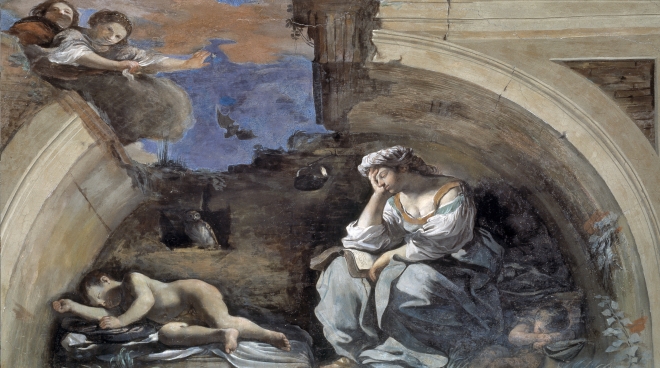
The western and eastern lunettes of Guercino’s Aurora (1621). Courtesy Amminstrazione Boncompagni Ludovisi
Although Cardinal Ludovisi would never have anticipated it, the symbolism of this part of the work does speak to the status of the family in the late 1800s and early 1900s.
Let us now finally return to the celebratory lunch in the Stanza dell’Aurora. If special significance was assigned to where the Duke of Fiano was seated at the meal, particular meaning was also attached to the placement of the rest of the family around the table.
Rodolfo and Agnese, their children, grandchildren and great grandchildren were seated in a careful scheme. The 1904 chart suggests what we would in any case expect, that the hierarchy at the table radiated out from the right of Rodolfo and the left of Agnese, in a meticulously ordered sequence.
The plan also had the effect of grouping the honorands and guests according to generation, signaling that this millennium-old noble family—which traced its origins back to the year AD 980 and the entry of Holy Roman Emperor Otto II to Italy—was still growing and that it had a great stake in the future. Sitting across the table from Rodolfo and Agnese, in their direct line of sight, was their great-grandson, now aged two.
Indeed, the emphasis of this gathering seems to have been on the future of the direct line of this couple. In 1904 Rodolfo still had three living younger siblings, all in Rome or the vicinity, two with surviving spouses: Maria Carolina Boncompagni Ludovisi (1834-1910, widow of Francesco Rospigliosi Pallavicini, 1828-1887), with a son; Ignazio Boncompagni Ludovisi (1845-1913) and his wife Teresa Marescotti (1848-1928); and Lavinia Boncompagni Ludovisi (1854-1938) and her husband Costanzo Taverna (1839-1913), with a daughter. For her part, Agnese at the time had nine living half-siblings, all children by her the second marriage of her father Marcantonio Borghese (1814-1886) with Thérèse de la Rochefoucauld (1823-1894). One must remember it was the children of Rodolfo and Agnese who planned the Casino Aurora event, and that explains the marked emphasis on the family’s future rather than its past.
For clarity, I have color-coded the generations present at the celebratory luncheon. Blue (3 members present): the generation of Rodolfo and Agnese. Red (8 members): the children of Rodolfo and Agnes, and their spouses. Green (15 members): the grandchildren of Rodolfo and Agnese. Purple (1 member): the great-grandchildren of Rodolfo and Agnese. In my notes, Rome is the location of all births, marriages and deaths listed below unless otherwise noted. There is much to be said about practically all individuals here listed, but I have kept biographical notes at a bare minimum, not going much beyond identification.
1R Papà: Rodolfo Boncompagni-Ludovisi, aged 72 in 1904. He was the first-born child of Antonio (III) Boncompagni Ludovisi (1808-1883, Prince of Piombino from 1841) and Guglielmina Massimo (1811-1899); born 6 February 1832 and died 12 December 1911. He married Agnes Borghese 31 May 1854.
1L Mammà: Agnese Borghese Boncompagni Ludovisi, aged 68 in 1904. She was the daughter of Marcantonio Borghese (1814-1886) and Gwendoline Catherine Talbot (1817-1840); born 5 May 1836 and died 22 March 1920.
2R M[arche]sa Cattaneo: Guendalina Boncompagni Ludovisi, aged 45 in 1904. She was the eldest daughter (third-born of six) of Rodolfo and Agnese. She was born 17 July 1859; married on 23 April 1879 Giovanni Battista Cattaneo della Volta (1897). A widow at the time of her parents’ anniversary celebration, she died 19 December 1942.
2L Duca di Fiano: Marco Boncompagni Ludovisi Ottoboni, aged 72 in 1904. He was the son of Alessandro Boncompagni Ludovisi Ottoboni (1805-1837) and Constanza Boncompagni Ludovisi (1811-1851). He was born on 21 April 1832. He served as a witness for Rodolfo and Agnes at their 1854 wedding, and then on 21 September 1857 in Albano Laziale married the sister of Rodolfo, Giulia Boncompagni Ludovisi (1839-1897). Created a Senator of the Kingdom of Italy in 1872, he died 29 March 1909.
3R Ugo: Ugo Maria Boncompagni Ludovisi, aged 48 in 1904. He was the eldest child of Rodolfo and Agnese. He was born 8 May 1856, and married twice—only to be twice a widower. His first marriage was to Vittoria Patrizi-Naro-Montoro (born 1857, who died in Paris in 1883); his second to Laura Altieri (1858-1892). After entering the priesthood in 1895, Ugo rose in the Vatican to the positions of Protonotario Apostolico and (from 5 February 1921) Vice Camerlengo of the Church. He died 9 November 1935.
3L D[uche]ssa Caffarelli: Maria Boncompagni Ludovisi, aged 35 in 1904. She was the daughter (sixth-born of six) of Rodolfo and Agnese; born 10 March 1869 and died on 9 January 1946. She married Francesco Caffarelli on 24 October 1888. It may be that she was the creator of the present seating plan.
4R Arduina: Arduina di San Martino di Valperga, aged 35 in 1904. She was the wife of Giuseppe Boncompagni Ludovisi (1865-1930), fifth-born child of Rodolfo and Agnese. She was born 14 October 1868 in Torino; married 15 November 1891; and died 25 May 1963.
4L Giuseppe: Giuseppe Maria Boncompagni Ludovisi, aged 39 in 1904. He was the son (fifth-born of six) of Rodolfo and Agnese. Born 22 March 1865; died 9 May 1930. On 15 November 1891 he married Arduina San Martino di Valperga (1868-1963).
5R Luigi: Luigi Maria Boncompagni Ludovisi, aged 46 in 1904. He was the son (the second-born child of six) of Rodolfo and Agnese. He was born 21 June 1857; married Isabella Rondinelli-Vitelli 24 October 1881 in Florence; and died 22 July 1928.
5L Isabella: Isabella Rondinelli-Vitelli, aged 43 in 1904. She was the wife of Luigi Maria Boncompagni Ludovisi (1857-1928), who was the second-born child of Rodolfo and Agnese. She was born 17 October 1861 in Florence; married 24 October 1881, also in Florence; and died 23 October 1957 in Rome.
6R M[arche]sa Malvezzi: Guendalina Boncompagni-Ludovisi, aged 26 in 1904. Granddaughter of Rodolfo and Agnese, she was the daughter of their son Ugo Boncompagni Ludovisi (1856-1935) and his first wife Vittoria Patrizi-Naro-Montoro (1857-1883), the first child from that union. She was born 26 November 1878, and married on 25 November 1897 Antonio Malvezzi Campeggi (born 13 August 1870 and died 8 April 1900, after just a bit more than two years of marriage). Guendalina herself died 25 November 1951 in Bologna.
6L Duca Caffarelli: Franceso Caffarelli, aged 39 in 1904. Born 2 February 1865, he married Maria Boncompagni Ludovisi, the daughter of Rodolfo and Agnese, on 24 October 1888. He died 28 December 1962.
7R C[on]te Campello: Pompeo Campello della Spina, aged 31 in 1904. He was the husband of Rodolfo and Agnese’s granddaughter Guglielmina Boncompagni Ludovisi (daughter of Ugo and his first wife Vittoria Patrizi.) He was born 22 December 1874; the couple had married 24 October 1900; he died on 6 October 1927 in Campello sul Clitunno (Umbria).
7L C[onte]ssa Campello: Guglielmina Boncompagni Ludovisi, aged 23 in 1904. Granddaughter of Rodolfo and Agnese; she was the daughter (second-born) of their oldest child Ugo Boncompagni Ludovisi (1856-1935) and his first wife Vittoria Patrizi-Naro-Montoro (1857-1883). Guglielmina was born 4 July 1881; she married Pompeo Campello Spina (1875-1927) on 24 October 1900; and died 2 May 1973.
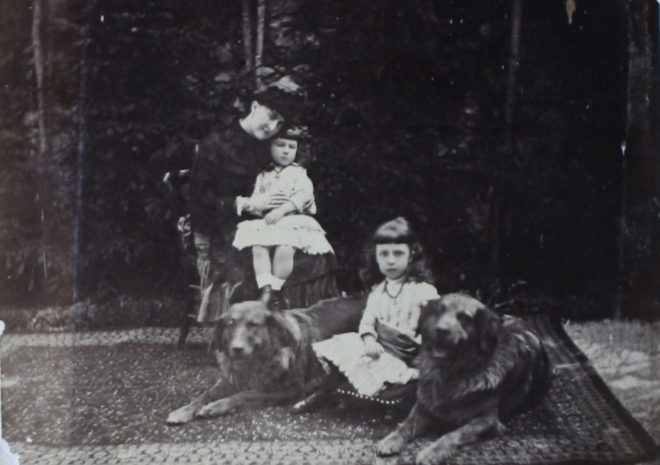
Photo (ca. 1884) of Ugo Boncompagni Ludovisi’s second wife, Laura Altieri (1858-1892), with the daughters from his first marriage Guglielmina (on lap) and Guendalina, listed respectively as 7L and 6R on the 1904 seating chart. Collection of HSH Prince Nicolò and HSH Princess Rita Boncompagni Ludovisi, Rome.
8R Eleonora: Eleonora Boncompagni Ludovisi, aged 19 in 1904. Granddaughter of Rodolfo and Agnese, she was the daughter of their oldest child Ugo Boncompagni Ludovisi (1856-1935) and his second wife Laura Altieri (1858-1892), the first-born child from that union. She was born 25 April 1885, and died on 3 March 1959 in Florence. At the time of the Golden Wedding celebrations of 1904 Eleonora had entered the Sacro Cuore order as a nun.
8L Francesco: Antonio Francesco Maria Boncompagni-Ludovisi, aged 17 in 1904. Grandson of Rodolfo and Agnese; he was the eldest son of their oldest child Ugo Boncompagni Ludovisi (1856-1935), and his first wife Vittoria Patrizi-Naro-Montoro (1857-1883). Born 20 October 1886 in Foligno (Umbria), he married Nicoletta Prinetti Castelletti (1891-1931) on 20 February 1908. For the story of their honeymoon (in which they visited several of the relations here at the table) see here. Since his father Ugo had renounced succession to the title of Prince of Piombino after the death of his second wife and entry into the priesthood (27 January 1895), Francesco became head of the family on his grandfather’s Rodolfo’s death in 1911. Governor of Rome from 1928-1935 and then an invaluable help to the Allied cause in World War II, he died 7 June 1955. His fascinating story will find mention often in subsequent posts on this blog.
9R Andrea: Andrea Boncompagni Ludovisi, aged 20 in 1904. Grandson of Rodolfo and Agnese, he was the son (first-born of four children, all male) of Luigi Boncompagni Ludovisi and Isabella Rondinelli-Vitelli. He was born 3 February 1884, and married twice. The first was on 25 October 1916 in Washington DC to the American Margaret Preston Draper (1891-1974); and then (after annulment) in Padua to the Swedish Alice Blanceflor Bildt (1894-1972). The couple lived during WW II in Princeton NJ; their residence in Rome at 18 Via Boncompagni is since 1995 the Museo Boncompagni Ludovisi. Andrea died 10 December 1948 in Montreux, Switzerland.
9L Vico: Lodovico Boncompagni Ludovisi, aged 14 in 1904. Grandson of Rodolfo and Agnese, he was the son (third-born of four children, all male) of Luigi Boncompagni Ludovisi and Isabella Rondinelli-Vitelli. He was born 16 February 1890 in Florence and died 23 February 1966 in Empoli. He does not seem to have married.
10R Teresa: Teresa Boncompagni Ludovisi, aged 15 in 1904. Granddaughter of Rodolfo and Agnese, she was the youngest daughter of their oldest child Ugo Boncompagni Ludovisi (1856-1935), and his second wife Laura Altieri (1858-1892). She was born 24 January 1889; married on 4 April 1910 Sigismondo Giustiani Bandini (1886-1918); and died 1 May 1969.
10L Pippo Caffarelli: Filippo or Philip Caffarelli, aged 13 in 1904. Grandson of Rodolfo and Agnese, he was the son (second of three) of their daughter Maria Boncompagni Ludovisi and Francesco Caffarelli. He was born on 5 June 1891; on 18 January 1926 he married Tecla von Ludolf (1897-1985) in Florence; he died 13 May 1975.
11R Paolo: Paolo Boncompagni Ludovisi, aged 18 in 1904. Grandson of Rodolfo and Agnese, he was the son (second-born of four children, all male) of Luigi Boncompagni Ludovisi and Isabella Rondinelli-Vitelli. He was born 19 December 1886; married 17 April 1910 in Florence Stefania Bourbon del Monte (1888-1984); he died on 16 April 1960.
11L Rosalia: Rosalia Boncompagni Ludovisi, aged 11 in 1904. Granddaughter of Rodolfo and Agnese, she was the daughter (elder of two children) of Giuseppe Boncompagni Ludovisi and Arduina San Martino di Valperga. She was born 26 February 1893; she married Georg Skouses (1891-1973) on 26 December 1918; and died 27 February 1977.
12R Peppe Caffarelli: Giuseppe Baldassare Caffarelli, aged 14 in 1904. Grandson of Rodolfo and Agnese, older brother of Carlo and Filippo Caffarelli, on whom see above and below. Born 3 April 1890; married 7 February 1917 Maria Carrega Bertolini (1889-1978); died 25 December 1983.
12L Bonny: Boncompagno Boncompagni Ludovisi, aged 8 in 1904. Grandson of Rodolfo and Agnese, he was the younger brother of Rosalia (above). He was born 25 October 1896, and died 3 May 1988 in New York City. He married twice: Carla Borromeo Arese (1897-1987) on 14 June 1917 in Milan; and (after divorce) Selma Borger (1901-1989) on 29 November 1947 in Reno NV. The story of his detention in the US during World War II and his subsequent major contributions to the Allied war effort will feature in future installments of this blog.
13R Balduccio: Baldassare Boncompagni Ludovisi, aged 3 in 1904. Grandson of Rodolfo and Agnese, he was the son (fourth-born of four children, all male) of Luigi Boncompagni Ludovisi and Isabella Rondinelli-Vitelli. He was born 30 October 1900; married Alba Gath (1897-1983) on 12 January 1927; and died 29 April 1973 in Panicale (Umbria).
13L Carlo Caffarelli: Carlo or Charles Caffarelli, aged 11 in 1904. Grandson of Rodolfo and Agnese, he was the son (third of three) of their daughter Maria Boncompagni Ludovisi and Francesco Caffarelli. Born 12 June 1893; married in Solt (Hungary) on 12 September 1921 Helene (Ilona) Nemes de Hídvég et Oltszem (1895-1982); died 20 December 1967.
14R+L Lanfranco: Lanfranco Campello della Spina, aged 2 in 1904. Great-grandson of Rodolfo and Agnese, he was the grandson of Ugo and Vittoria Patrizi, and son (first-born of what would be five children) of their daughter Guglielmina Boncompagni Ludovisi and her husband Pompeo Campello Spina. He was born 16 September 1901 in Campello sul Clitunno (Umbria); married on 12 April 1923 Agnese Macchi Cellere (1902-1966); and died 20 March 1969.
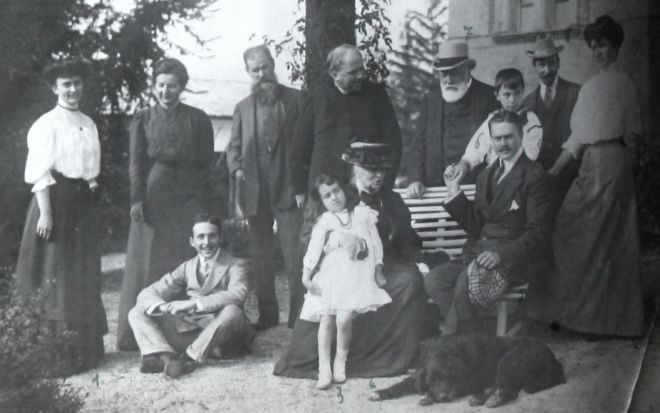
Four generations of Boncompagni Ludovisi at the Villa ‘La Quiete’ 20 October 1907. Standing behind center of bench (with hat) is Rodolfo Boncompagni Ludovisi (1R in the luncheon plan), and seated at center is his wife Agnese Borghese (1L), with granddaughter Maria Campello della Spina (1902-1987, not at luncheon) on lap. Standing behind Agnese, in clerical garb, is her son Ugo (3R). Also pictured: standing at far right, Ugo’s daughter (from first marriage) Guglielmina (7L). Standing at far left, Ugo’s daughter (from second marriage) Teresa (10R); sitting, on right of bench, his son Francesco (8L), holding the hand of Guglielmina’s son Lanfranco Campello (14RL). Directly to the right of the boy is the Boncompagni Ludovisi family agent, Sig. Rocchi. Collection of HSH Prince Nicolò and HSH Princess Rita Boncompagni Ludovisi, Rome.
According to Ugo Boncompagni Ludovisi in Ricordi di mia madre, after the lunch, his parents departed from the Casino dell’Aurora and returned to the sitting room in the Via della Scrofa, where they remained. Neither newspaper reports nor Ugo’s memoirs mention whether they came away with a greater sense of self.
But perhaps there is truth, if not proof, that spending a day beneath Guercino’s Aurora would have achieved the family’s purpose in celebrating the Nozze d’Oro at the Casino dell’Aurora, in the writings of Henry James.
In his 1873 essay in From a Roman Note-Book, James noted “the Ludovisi Casino is small, but the perfection of the life of ease might surely be led there… you have Guercino above your head…One might live over again…some deliciously benighted life of forgotten type.”
About the author: Carol Cofone, a senior at Rutgers University, pursuing a second degree in Italian, and a certificate in Historic Preservation, has been associated with the Archivio Boncompagni Ludovisi since 2014. She is a recipient of a 2013, 2014 and 2015 Rutgers Academic Excellence Award. She is also a Research Fellow for Float (http://float.travel) a mobile app that geolocates the New York pedestrian, maps the art, architecture and historical sites in the vicinity and tells their stories. She has written Float stories specific to the work of the Municipal Arts Society and is now developing ones for the Tribeca Trust.
Thanks to Nicoletta Romano (Rutgers’16) for her help in deciphering an inscription on the calling card of the Duke of Fiano; and to Corey Brennan for editorial guidance.
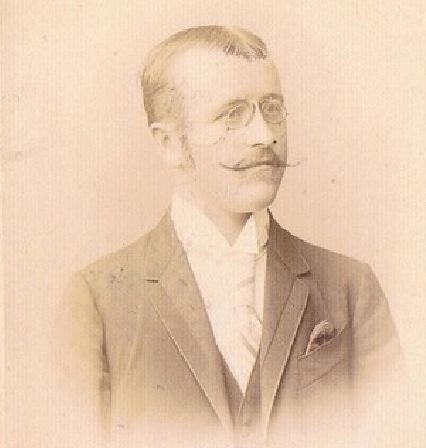
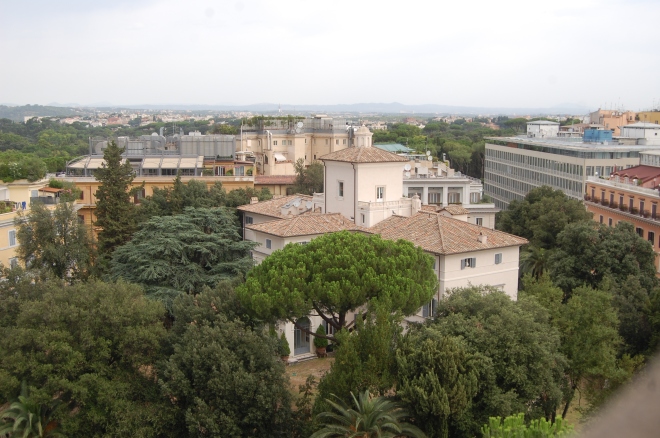
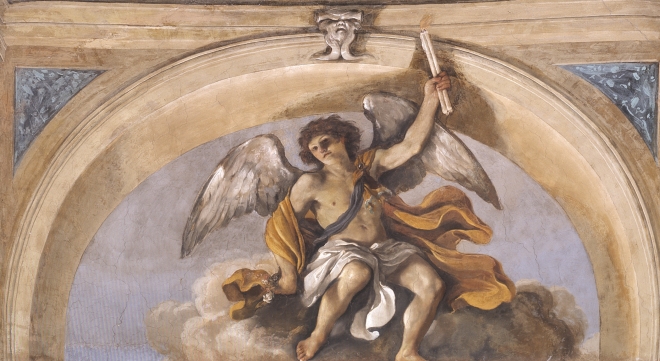
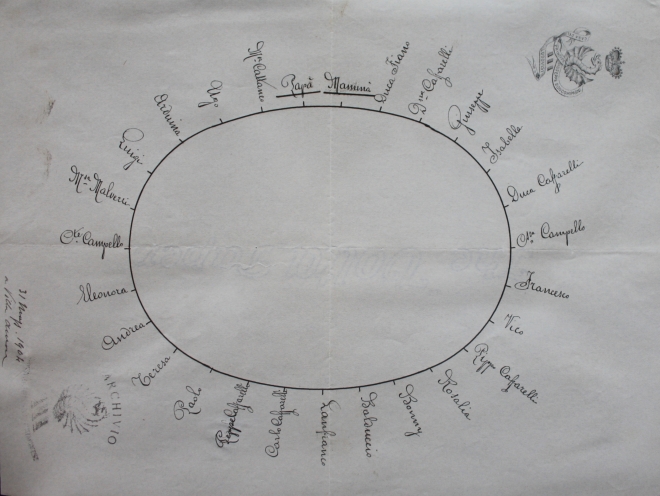
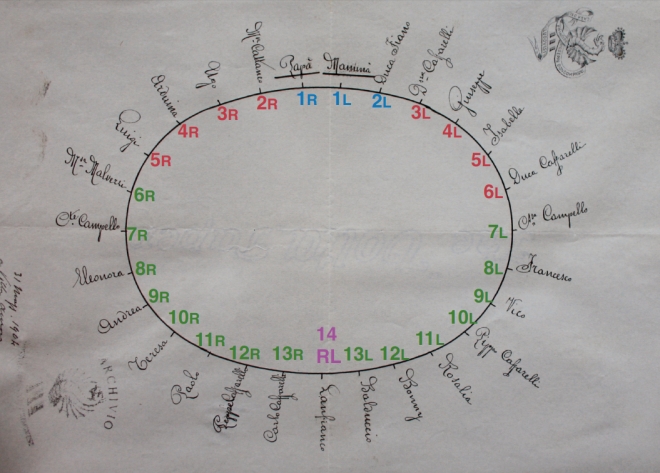
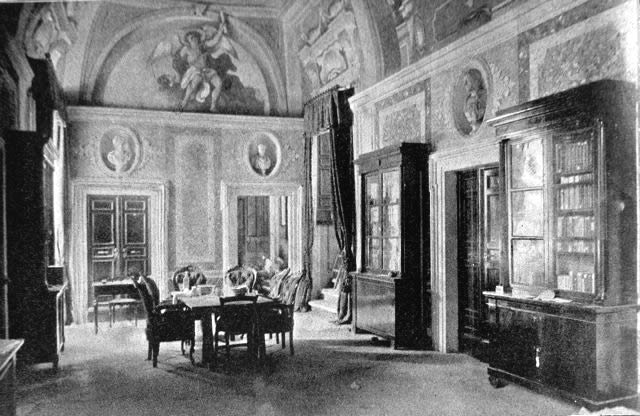
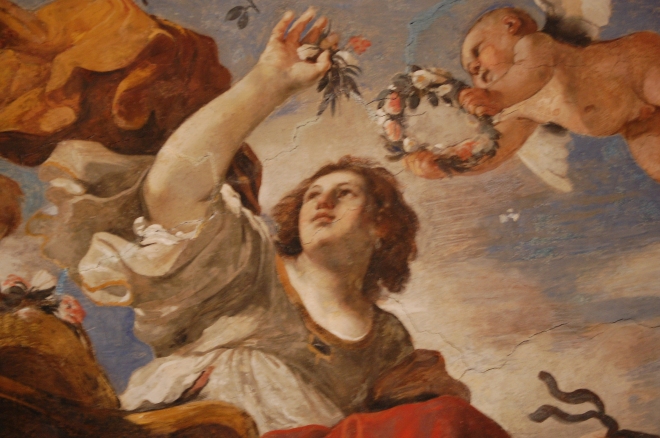
Congratulations Carol Cofone, this is excellent. Princess Agnese was a wonderful person as is her family. As daughter of Gwendalin Talbot Borghese she could not have had a better role model.Her Grandmother Maria Theresa Talbot was Irish, born in Castle Talbot , Co. Wexford. Carol if you contact me by email I shall send you a copy of my research on the Irish connection, which you and your readers will find most interesting. With best wishes,
Mary Stratton Ryan, Irish Art Historian and Independent scholar.